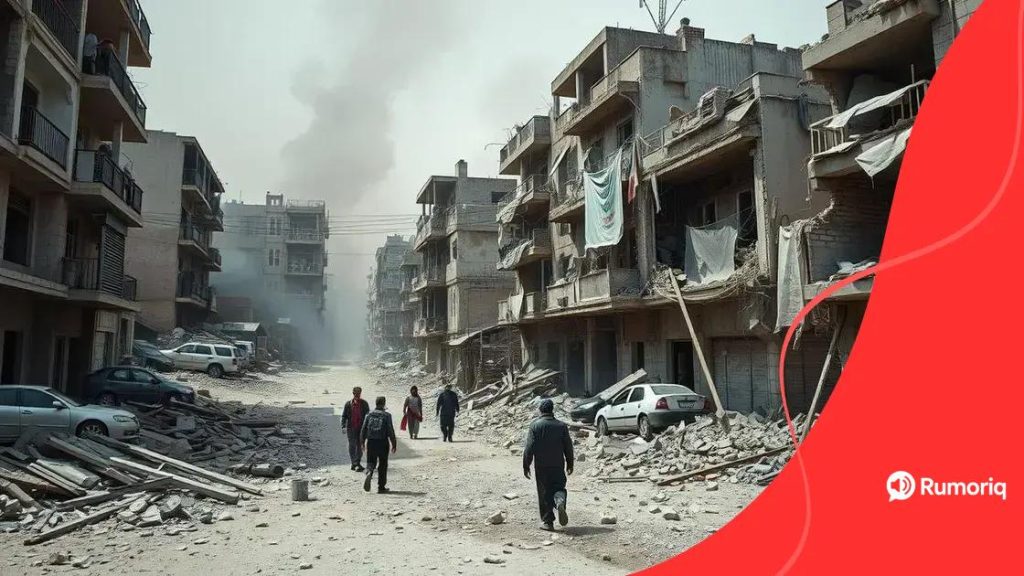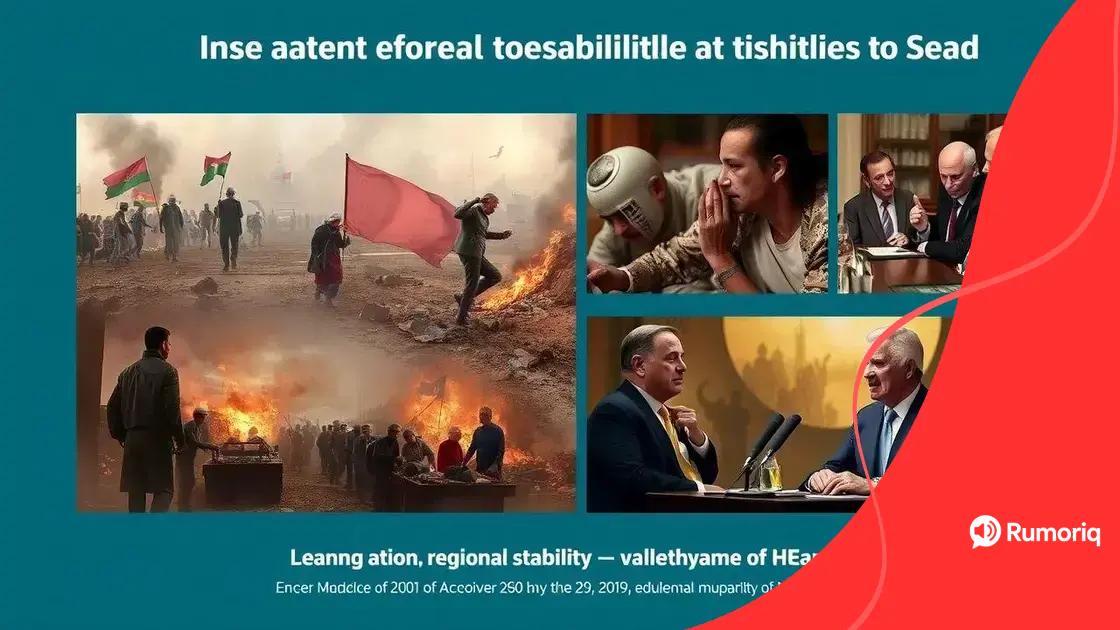Recent developments in conflicts within the Middle East

Anúncios
Recent developments in conflicts within the Middle East involve shifts in power dynamics, increased humanitarian concerns, and varying responses from international players, creating a complex landscape for potential peace solutions.
Recent developments in conflicts within the Middle East have drawn global attention as tensions escalate and new alliances form. Have you considered how these changes impact the world around us?
Anúncios
Understanding the historical context of Middle East conflicts
To grasp the complexities of conflicts in the region, it is vital to understand the historical context. The Middle East has faced numerous conflicts over the decades, stemming from various political, religious, and cultural tensions. Historical events have shaped the interactions among different nations and groups, leading to ongoing disputes.
Key Historical Events
Several key events have significantly influenced the current landscape. The establishment of Israel in 1948 marked a turning point, initiating tensions that continue to resonate today. Other critical moments include:
- World War I and the dissolution of the Ottoman Empire.
- The Suez Crisis of 1956, altering power dynamics.
- The Arab Spring of 2010-2011, sparking widespread protests.
These pivotal events illustrate how historical disputes over land, resources, and governance have perpetuated conflicts. The ongoing issues arise from a mix of nationalistic aspirations and ethnic divisions, further complicating the situation.
Anúncios
Religious Tensions
Religious differences also play a key role in the conflicts. The animosity between Sunni and Shia Muslims is one significant aspect that affects relations in the Middle East. Across the region, this division has led to violence and heightened tensions in several countries.
In addition to religious issues, foreign interventions have often exacerbated the situation. International powers have a lengthy history of involvement in the region, trying to promote stability but sometimes inadvertently causing more strife.
Key players and stakeholders in current disputes
Understanding the key players and stakeholders in current disputes is crucial for analyzing conflicts in the Middle East. Various nations, organizations, and groups have significant influence over the events unfolding in the region. Each player brings their own interests and agendas, adding layers of complexity to the situation.
Major Countries Involved
Several countries play pivotal roles in the ongoing conflicts. Notable examples include:
- Israel – A central figure in much of the conflict, with territorial disputes and security concerns.
- Iran – A major supporter of various groups and seen as a threat by many regional powers.
- Saudi Arabia – Involved in various conflicts, often positioning itself against Iran.
These nations often align with or against each other based on shifting political landscapes and alliances. The relationships among these players can drastically affect the balance of power.
Non-State Actors
In addition to countries, non-state actors significantly influence the conflicts. Groups such as Hezbollah, Hamas, and various militias engage in conflicts that affect both local and global dynamics. These organizations often have local support, which complicates efforts for peace.
The international community also plays a vital role, with organizations like the United Nations and NATO trying to mediate. However, their effectiveness can be limited by the interests of member nations and the complexities of the conflicts themselves.
Impact of recent events on regional stability

The impact of recent events on regional stability in the Middle East has been profound, shaping not only local politics but also international relations. With changes occurring rapidly, analyzing these impacts helps us understand the ongoing challenges.
Shifts in Power Dynamics
Recent developments have led to significant shifts in power dynamics. Countries that were once considered stable now face unrest due to economic struggles and political mismanagement. Notably:
- Increased tensions between major powers like Iran and Saudi Arabia affect alliances.
- Emergence of new political movements threatens established regimes.
- The role of foreign nations complicates these dynamics further, influencing local disputes.
A major event that exemplifies this shift is the exit of foreign troops from conflict zones. This withdrawal often leaves a power vacuum, leading to increased conflict as local factions vie for control.
Humanitarian Concerns
Alongside political instability, there are serious humanitarian concerns. Recent conflicts have triggered waves of refugees seeking safety. Countries neighboring conflict zones are grappling with:
- The influx of displaced individuals, straining resources.
- Emerging health crises due to overcrowding in camps.
- The need for humanitarian aid, which often faces logistical challenges.
Overall, these dynamics perpetuate a cycle of instability, as humanitarian issues lead to further unrest. Addressing these challenges requires coordinated international efforts to provide support and promote peace.
International response to ongoing conflicts
The international response to ongoing conflicts in the Middle East has evolved significantly over the years. Various organizations and countries work together, but their approaches often differ based on national interests and regional dynamics.
United Nations Involvement
The United Nations plays a crucial role in addressing conflicts through peacekeeping missions and resolutions. However, the effectiveness of these efforts can be hampered by political disagreements among member states. For instance:
- Peacekeeping forces are deployed in areas of tension.
- Resolutions often face vetoes from major powers, stalling action.
- Humanitarian aid is sometimes delayed due to bureaucratic challenges.
Despite these obstacles, the UN continues to seek diplomatic solutions, often facilitating dialogues between conflicting parties.
Role of Regional Powers
Regional powers, such as Turkey and Egypt, also influence the response to conflicts. They often act based on their interests, which may lead to:
- Direct military intervention in some cases, such as in Libya.
- Diplomatic negotiations to resolve disputes.
- Support for specific factions, complicating peace efforts.
Moreover, the relationships between these regional players can shift quickly, impacting the overall stability of the area.
The involvement of global powers such as the United States and Russia further complicates responses. These nations often have strategic interests in the region, leading to different levels of support for various groups. As a result, international responses are sometimes viewed as inconsistent or biased.
Future outlook for peace in the Middle East
The future outlook for peace in the Middle East depends on various factors, including the commitment of local leaders and the influence of international players. Achieving lasting peace requires addressing the root causes of conflicts and building trust among parties.
Pathways to Peace
Several potential pathways could lead to peace in the region. These include:
- Negotiated Settlements – Direct talks between conflicting parties can pave the way for agreements that address key issues.
- Inclusive Governance – Ensuring all groups feel represented can help reduce tensions and prevent conflict.
- Economic Cooperation – Collaborative projects can foster interdependence and mutual benefits, making conflict less desirable.
Each of these pathways offers a glimpse into how peace might be achieved, although they may take time to materialize.
Role of the International Community
The international community plays a critical role in supporting peace efforts. Organizations like the United Nations and various NGOs provide essential resources and expertise. Their involvement helps to:
- Facilitate dialogue through diplomatic channels.
- Offer humanitarian aid to those affected by conflict.
- Monitor ceasefires and peace agreements.
While the international presence can be helpful, it must be careful not to impose solutions. Local ownership of peace processes is vital for success.
Overall, the future of peace in the Middle East remains uncertain. While challenges persist, avenues for progress exist. Fostering dialogue, ensuring equitable governance, and enhancing international cooperation may create a more hopeful landscape.
In conclusion, the journey toward peace in the Middle East is complex and challenging. Understanding the historical context, key players, and international responses is crucial. While there are many obstacles to peace, the potential pathways offer hope for a stable future. By focusing on dialogue, cooperation, and addressing humanitarian needs, meaningful progress can be made. With continued efforts and commitment from local and international communities, a peaceful resolution may one day be achieved.
FAQ – Common Questions About Recent Developments in Middle East Conflicts
What are the main causes of ongoing conflicts in the Middle East?
The main causes include historical grievances, territorial disputes, and religious differences among various groups.
How do international organizations contribute to peace efforts?
International organizations like the UN facilitate dialogue, provide humanitarian aid, and monitor peace agreements among conflicting parties.
What role do local leaders play in the peace process?
Local leaders are essential for negotiations, as they represent the interests of their communities and can foster trust among opposing factions.
Is there hope for a peaceful resolution in the Middle East?
Yes, despite challenges, pathways to peace exist through negotiation, cooperation, and addressing humanitarian needs.